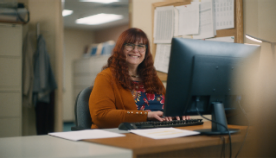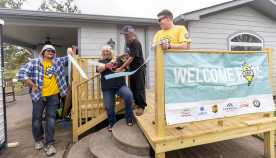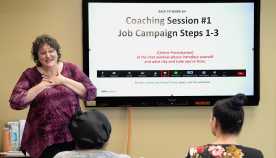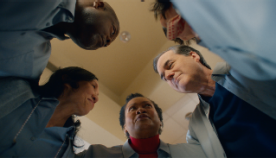About Us


We’re pleased to share the latest edition of To Serve, the AARP Foundation newsletter that highlights our impact in communities across the country. With your support, progress is possible.
- Putting older adults on the road to food security
- Helping one veteran get back to work
- The push for paid caregiving
- Defending seniors against age discrimination
Putting Older Adults on the Road to Food Security
Tom McSpedden’s road to food security was a long one. The 70-year-old Californian had worked as a truck driver until a heart attack landed him in the hospital. That’s when Tom made what he calls a catastrophic mistake.
“When I got out of the hospital, they said I owed them a million something dollars,” he says. “I gave them everything I’d saved because I thought I had to.”
Without an income, Tom became dependent on Social Security disability benefits. He also enrolled in CalFresh, California’s name for SNAP (Supplemental Nutrition Assistance Program, formerly called food stamps). At first, he received just $67 a month in benefits. Even when that amount increased, it wasn’t enough.
As a result, Tom often limited himself to two small “meals” a day: a piece of fruit in the morning, and a hot dog or bologna sandwich in the afternoon. As someone with type 2 diabetes, Tom needed high-fiber whole grains and vegetables — not hot dogs and bologna sandwiches.
Tom isn’t alone in struggling to put nutritious food on the table. Nearly 11.8 million people over 50 are at risk of going hungry, and programs like SNAP can be tough for older adults to access. Barriers such as stigma, a lack of information, and digital literacy restraints keep many adults from applying. In fact, just 37% of eligible people over 50 are currently enrolled – much lower participation than those in other age groups.
That’s why AARP Foundation’s SNAP grants are so crucial. By collaborating with 19 community organizations in 22 states, we’re connecting older adults like Tom to the food they need. In 2023 alone, we helped hungry seniors access more than $105 million in SNAP benefits.
An AARP Foundation grant ultimately helped put Tom on the path to food security. After a pandemic-era benefit increase ended in 2023, he reached out to Sacramento Food Bank & Family Services (SFBFS), an AARP Foundation grantee, and was connected with CalFresh specialist Erika Murdoch. Erika’s expertise helped Tom qualify for a larger benefit so he can afford the food he needs.
As Tom puts it, "Erika found a way to help me survive."
This kind of collaboration is what makes AARP Foundation’s approach so successful. By working with SFBFS and other local organizations, we can help all older adults access the benefits they deserve — and the nutritious food they need.
Watch Tom and Erika in our community heroes video series
Helping One Veteran Get Back to Work


For Jamie Aranda, the call to serve has always been strong. The 61-year-old Californian joined the U.S. Air Force at 18, then found fulfilment with the ALS Association, a nonprofit. Helping others “is what really makes me tick,” Jamie says.
After a move, Jamie struggled to find a meaningful job she could hold until retirement — until she reached out to AARP Foundation’s BACK TO WORK 50+ program. BACK TO WORK 50+ helps adults over 50 find work through free workshops, coaching and more. With the assistance of a career coach, Jamie found the perfect position as an office technician at the Veterans’ Home of California. “I’m a veteran and I’m serving veterans. It's so meaningful to me,” says Jamie.
The Push for Paid Caregiving

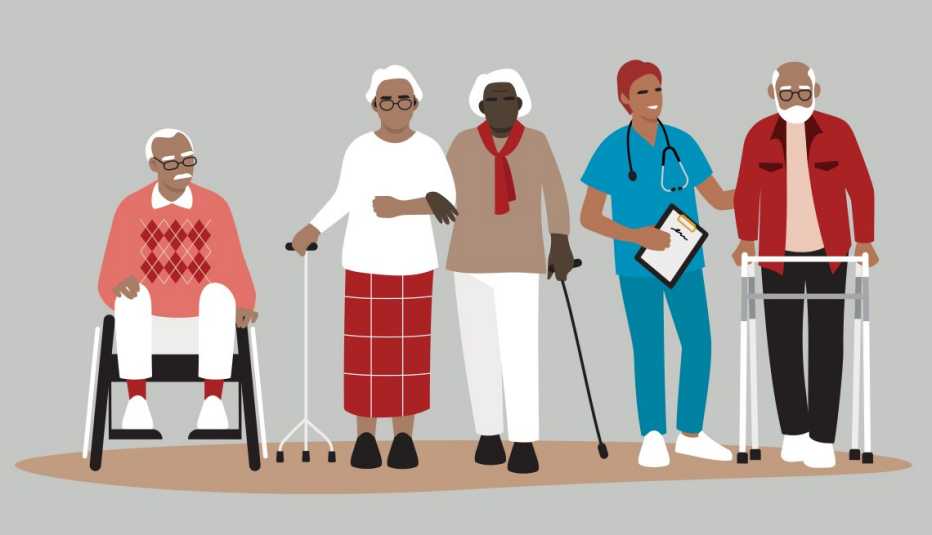
Across the U.S., nearly 48 million people care for an adult family member or other loved one. While caregiving can be a rewarding task, it’s also a difficult and costly one: American caregivers average 24 hours of care work a week, and three-quarters spend an average of $7,200 on caregiving-related expenses yearly. In addition, 30% of caregivers are part of the “sandwich generation” — people who care for an older family member and a child or grandchild.
And on top of keeping a loved one safe, clean and healthy, 6 in 10 family caregivers also work a full-time or part-time job. It’s a lot to balance — 40% of family caregivers who also hold paid jobs say that the emotional stress of all this juggling is their biggest challenge.
Some states pay caregivers for their work — but navigating the requirements and rules can be tricky. Each state’s Medicaid program has different requirements and rules, and many have long wait lists. That’s why AARP Foundation, with the support of UnitedHealthcare, has developed the AARP Foundation Paid4CareTM hub — a one-stop-shop for deciding whether paid caregiving is right for you.
This user-friendly resource covers all things paid caregiving: state requirements, the risks and benefits, the skills you need to qualify, and more. There’s even a handy glossary to help explain the jargon.
For too many caregivers, helping loved ones means taking on debt, carrying unpaid bills, or even leaving their jobs. But with the help of the AARP Foundation Paid4Care hub more caregivers can learn about the possibilities of paid caregiving — and decide if it’s right for them and their family.
Learn more about paid caregiving
Defending Seniors Against Age Discrimination


When Mark H. Goldstein applied for a job at Raytheon — a government defense and aerospace contractor — in 2019, he met most of the job requirements: He holds a master’s degree in business administration, previously held a security clearance, and has a certification in cybersecurity.
But Mark wasn’t optimistic about his chances. He was in his sixties, but the position required that applicants be “currently enrolled or a recent graduate (within 18 months)” of a graduate school program.
"Every bone in your body says, ‘Your chances of getting this job are practically zero, because they are biased against older employees,’ ” Mark said AARP. “But you try anyway.”
Mark didn’t get that job, nor any other at Raytheon. So he decided to fight back.
Mark joined AARP Foundation, Peter Romer-Friedman Law PLLC, and Outten & Golden LLP to file a class action age discrimination lawsuit against Raytheon (now known as RTX Corporation).
The lawsuit alleges that Raytheon refused to hire workers unless they recently finished college or graduate school, a requirement that prevented Mark and many others from getting hired. It may also have stopped thousands of older Americans from applying in the first place, says Peter Romer-Friedman, a lawyer working on the case.
This isn’t the first time Raytheon has been called out for violating older workers’ rights. In 2021, after Mark filed a complaint with the Equal Employment Opportunity Commission (EEOC), the agency found that Raytheon’s hiring practices violated the federal Age Discrimination in Employment Act (ADEA).
According to the EEOC, phrases such as “age 25 to 35,” “young,” and “recent college graduate” all deter older people from applying and are violations of the ADEA. Despite the findings, Raytheon only slightly changed its hiring practices, instead asking for applicants with one to two years of work experience.
AARP Foundation’s lawsuit highlights this ongoing issue. “Americans are living and working longer than ever, yet unfair and discriminatory hiring practices are keeping older workers from jobs they’re qualified for,” says William Alvarado Rivera, senior vice president for litigation at AARP Foundation. “All workers, regardless of their age, should have an equal opportunity to compete for jobs at Raytheon and everywhere else,” adds Mark.
Learn more about our latest litigation
AARP Foundation is an AARP Charitable Affiliate
Providing for AARP Foundation’s programs and services requires funding beyond AARP membership dues. That’s what makes your voluntary support so important at this time. Make a secure donation online.


